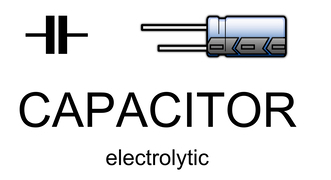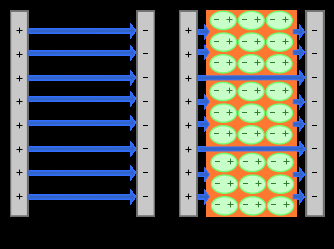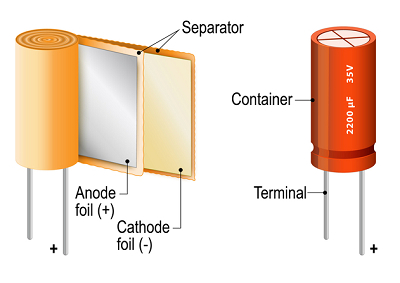Introduction
Capacitors are components used for two purposes – filtering and coupling. They are powered in a circuit with DC sources to acquire charge and dissipate the charge. Out of four types of capacitors which are discussed in detail in the coming sections, the electrolytic capacitor has a special construction utilizing chemical gel as one of the electrodes. The gel, foil, and dielectric coating of aluminum oxide design help to provide a high capacitance value with minimum size. This article conveys the general concepts of capacitors with a focus on electrolytic capacitors. It is important to note that alternate current should not be connected with electrolytic capacitors since charging and discharging happen instantly without any purpose.
What is a Capacitor?
 A capacitor is a passive electronic component that stores energy and dissipates energy in circuits. It has two terminals anode and a cathode. When a voltage of V volts is applied across capacitor terminals, if a charge of Q coulombs is developed across its plates, then the capacitance of the capacitor C (measured in Farads) is represented by the equation
A capacitor is a passive electronic component that stores energy and dissipates energy in circuits. It has two terminals anode and a cathode. When a voltage of V volts is applied across capacitor terminals, if a charge of Q coulombs is developed across its plates, then the capacitance of the capacitor C (measured in Farads) is represented by the equation
C=QVC=QV
Another way of measuring capacitance is when the dielectric constant is known (Let it be e) and when the distance between the plates is known (Let it be d) and when the area of plates is known (Let it be A). Then C=ϵAdC=ϵAd where ϵ=K×ϵ0ϵ=K×ϵ0. Here, K is the dielectric constant of the material and ϵϵ is that of the vacuum. When all other parameters are equal, when the plate area of a capacitor is increased, the capacitance increases. In the case of the distance between plates, closer plate spacing gives more capacitance. When permittivity, the dielectric constant is considered, the higher the permittivity, the greater will be the capacitance.
Explore our latest online courses and learn new skills at your own pace. Enroll and become a certified expert to boost your career.
Principle of Capacitor
The principle of the capacitor can be explained by its characteristics of it as well as by its construction. The out-of-the-box features of a capacitor are that it has two terminals, a body with an insulated sleeve, and the value of capacitance and working voltage imprinted on the body. Different construction methods create different types of capacitors.

A schematic example of a capacitor with and without a polarised dielectric
KondensatorZDielektrykiem.svg: *KapasitorMetGepolariseerdeDiëlektrikum.svg: FJL derivative work: RJB1 (talk) derivative work: MikeRun, Capacitor-with-and-withoutdielectricum, marked as public domain, more details on Wikimedia Commons
The capacitor working principle revolves around the charging cycle and discharge cycle. The plate connected to the positive end of the battery gets a positive charge while the plate identified with the negative terminal gets a negative charge. The charging continues till it reaches the same voltage as the battery. Further charging stops and the capacitor holds this charge till it is discharged by some means. During the discharge cycle, the plates get neutralized as current flows through a load. An electrical field is built around the capacitor during the charging cycle since the dielectric material (insulator) prevents any flow of charge between plates.
Types of Capacitor

Film Capacitors
One of the common types of capacitors is film capacitors. They are easily available and their dielectric properties make them unique. The dielectrics they use include polycarbonate, polypropylene, polyester, and Teflon. They are also called plastic capacitors. High reliability, long service life, withstanding high-temperature environments, etc are some of the advantages of plastic capacitors.
Dielectric Capacitors
Dielectric capacitors are a variation type, which uses multiple plates with rotors so that plates can be moved. These capacitors are used as variable-type capacitors and preset capacitors known as trimmers.
Ceramic Capacitors
Ceramic capacitors are also called disc capacitors. They are made with silver coating on ceramic disks. A 3-digit code printed on its body can be used to determine its capacitance value.
Electrolytic Capacitors
Electrolytic capacitors are made using a gel-type cathode (electrolyte) and thin-film layer as an anode. It can have high capacitance values with a small size and is hence used in coupling and decoupling applications.
Electrolytic Capacitor
 The dielectric medium of electrolytic capacitors is a thin anodized aluminum oxide layer and an ionic liquid acts as one of the plates. It will give an insight if we get to know a capacitor deep inside visually and its output. Electrolytic capacitors are unique from other types based on the construction design. The diagram here reveals the capacitor’s inner workings and the output characteristics are provided in the next section.
The dielectric medium of electrolytic capacitors is a thin anodized aluminum oxide layer and an ionic liquid acts as one of the plates. It will give an insight if we get to know a capacitor deep inside visually and its output. Electrolytic capacitors are unique from other types based on the construction design. The diagram here reveals the capacitor’s inner workings and the output characteristics are provided in the next section.
The above diagram shows the inside view of an electrolytic capacitor. The outer insulating sleeve covering the aluminum can is what we can see from the outside. The paddle tab on one of the terminals is an inner aluminum connection part. The anode is covered with a dielectric material, while the cathode is the electrolyte gel embedded in the paper spacer (brown). The rubber sealing and terminal leads are set diligently using a compact design. The anode, the cathode, and the dielectric are so placed that they are rolled together to reduce space.
Characteristics of Electrolytic Capacitor
Different characteristics of a capacitor are −
- Capacitance
- Working Voltage
- Type – plastic, ceramic, electrolytic, dielectric
- Leakage Current
- Tolerance
- Working Temperature
- Temperature Coefficient
- Equivalent series resistance
- Polarisation
Each of these features has to be explored in detail for a fair understanding and behavior of one concerning another. Some of the graphs that can be plotted are
- Temperature characteristics [X-axis] of capacitance [Y-axis]
- Frequency characteristics [X-axis] of capacitance [Y-axis]
- Leakage current [[Y-axis] Vs Time [X-axis]
- Temperature characteristics [X-axis] of leakage current [Y-axis]
The details of these graphs are not within the scope of this article.
The Material Used In Electrolytic Capacitor
The most used material in the construction of electrolytic capacitors is Tantalum, which is used for the anode. Aluminum and Niobium are also used in Electrolytic capacitors.
Leave a Reply